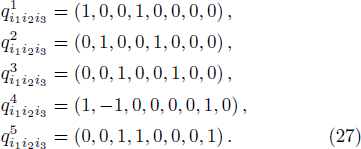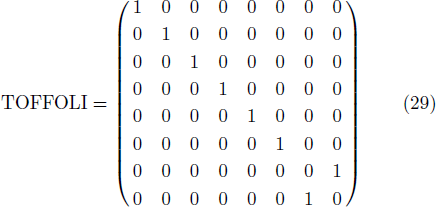† Corresponding author. E-mail:
Supported by FPA2012-35453
We develop a new geometric approach to deal with qubit information systems using colored graph theory. More precisely, we present a one to one correspondence between graph theory, and qubit systems, which may be explored to attack qubit information problems using toric geometry considered as a powerful tool to understand modern physics including string theory. Concretely, we examine in some details the cases of one, two, and three qubits, and we find that they are associated with CP1, CP1 × CP1 and CP1 × CP1 × CP1 toric varieties respectively. Using a geometric procedure referred to as a colored toric geometry, we show that the qubit physics can be converted into a scenario handling toric data of such manifolds by help of hypercube graph theory. Operations on toric information can produce universal quantum gates.
Toric geometry is considered as a nice tool to study complex varieties used in physics including string theory and related models.[1–2] The key point of this method is that the geometric properties of such manifolds are encoded in toric data placed on a polytope consisting of vertices linked by edges. The vertices satisfy toric constraint equations which have been explored to solve many string theory problems such as the absence of non abelian gauge symmetries in ten dimensional type II superstring spectrums.[3]
Moreover, toric geometry has been also used to build mirror manifolds providing an excellent way to understand the extension of T-duality in the presence of D-branes moving near toric Calabi–Yau singularities using combinatorial calculations.[4] In particular, these manifolds have been used in the context of N = 2 four-dimensional quantum field theories in order to obtain exact results using local mirror symmetry.[3] Besides such applications, toric geometry has been also explored to understand a class of black hole solutions obtained from type II superstrings on local Calabi–Yau manifolds.[5–6]
Recently, the black hole physics has found a place in quantum information theory using qubit building blocks. More precisely, many connections have been established in the context of STU black holes as proposed in Refs. [7–9].
More recently, an extension to extremal black branes derived from the Tn toroidal compactification of type IIA superstring have been proposed in Ref. [10]. Concretely, it has been shown that the corresponding physics can be related to n qubit systems via the real Hodge diagram of such compact manifolds. The analysis has been adopted to Tn|n supermanifolds by supplementing fermionic coordinates associated with the superqubit formalism and its relation to supersymmetric models.
The aim of this paper is to contribute to this program by introducing colored toric geometry and its relation to graph theory to approach qubit information systems. The main objective to deal with qubit systems using geometry considered as a powerful tool to understand modern physics such as string theory and related models. As an illustration, we examine lower dimensional qubit systems. We consider in some details the cases of one, two and three qubits. In particular we find that they are linked with CP1, CP1 × CP1 and CP1 × CP1 × CP1 toric varieties respectively. Using a geometric procedure referred to as colored toric geometry, we show that the qubit physics can be converted into a scenario working with toric data of such manifolds by help of graph theory.
The present paper is organized as follows. Section
Before giving a colored toric realization of qubit systems, we present an overview on ordinary toric geometry. It has been realized that such a geometry is considered as a powerful tool to deal with complex Calabi-Yau manifolds used in the string theory compactification and related subjects.[2] Many examples have been elaborated in recent years producing non trivial geometries.
Roughly speaking, n-complex dimensional toric manifold, which we denote as 










The simplest example in toric geometry, playing a primordial role in the building block of higher dimensional toric varieties, is CP1. It is defined by r = 1 and the Mori vector charge takes the values qi = (1, 1). This geometry has a U(1) toric action CP1 acting as follows


The second way is to consider a class of toric varieties that we are interested in here given by a trivial product of one-dimensional projective spaces CP1’s admitting a similar description. We will show later on that this class can be used to elaborate a graphic representation of quantum information systems using ideas inspired by graph theory and related issues. For simplicity reason, we deal with the case of CP1 × CP1. For higher dimensional geometries 



Inspired by combinatorial computations in quantum physics, we explore colored toric geometry to deal with qubit information systems.[7–20] Concretely, we elaborate a toric description in terms of a trivial fibration of one-dimensional projective space CP1’s. To start, it is recalled that the qubit is a two state system which can be realized, for instance, by a 1/2 spin atom. A superposition of a single qubit is generally given by the following Dirac notation






Roughly, the qubit systems can be represented by colored toric diagrams having a strong resemblance with hypercube graphs. A close inspection in hypercube graph theory and toric varieties shows that we can propose the following correspondence connecting three different subjects.
| Table 1
This table presents a one to one correspondence between colored toric geometry, hypercube graphs, and qubit systems. . |
To see how this works in practice, we first change the usual toric geometry notation. Inspired by combinatorial formalism used in quantum information theory, the previous toric data can be rewritten as follows



In colored toric geometry langauge, it is represented by 4 vertices vi1i2, belonging to Z2, linked by four edges with two different colors c1 and c2. The toric data require the following vertices

Due to this representation, we can relate the basis of n-qubit with the toric geometry. The mapping is given by

Having examined the qubit object, we move now to build the quantum gates using colored toric geometry and graph theory. The general study is beyond of the scope of this paper. We consider, however, lower dimensional cases. To do so, it is recalled that the classical gates can be obtained by combining Boolean operations as AND, OR, XOR, NOT, and NAND. In fact, these operations act on input classical bits, taking two values 0 and 1, to produce new bits as output results. In quantum computation, gates are unitary operators in a 2n-dimensional Hilbert space. In connection with representation theory, they can be represented by 2n × 2n matrix, belonging to SU(2n) Lie group, satisfying the following properties




For 2-qubits, there are many universal gates. As mentioned previously, this system is associated with the toric geometry of CP1 × CP1. Unlike the 1-qubit case corresponding to CP1 × CP1, the quantum systems involve two different data namely the vertices and colors. Based on this observation, such data will produce two kinds of operations:
Color actions. Vertex actions.
In fact, these operations can produce CNOT and SWAP gates. To get such gates, we fix the color action according to particular orders used in the corresponding notation. Following the colored toric realization of the 2-qubits, the color actions can be formulated as follows








The TOFFOLI gate represented by 23 × 23 matrix


Using toric geometry/hypercube graph correspondence, we have discussed qubit information systems. More precisely, we have presented a one to one correspondence between three different subjects namely toric geometry, Hypercube graph and quantum information theory. We believe that this work may be explored to attack qubit system problems using geometry considered as a powerful tool to understand modern physics. In particular, we have considered in some details the cases of one, two and three qubits, and we find that they are associated with CP1, CP1 × CP1 and CP1 × CP1 × CP1 toric varieties respectively. Developing a geometric procedure referred to as colored toric geometry, we have revealed that the qubit physics can be converted into a scenario turning toric data of such manifolds by help of graph theory. We have shown that operations on such data can produce universal quantum gates.
This work comes up with many open questions. A natural one is to examine super-projective spaces. We expect that this issue can be related to superqubit systems. Another question is to investigate the entanglement states in the context of toric geometry and its application including mirror symmetry. Instead of giving a speculation, we prefer to comeback to these open questions in future.
| [1] | |
| [2] | |
| [3] | |
| [4] | |
| [5] | |
| [6] | |
| [7] | |
| [8] | |
| [9] | |
| [10] | |
| [11] | |
| [12] | |
| [13] | |
| [14] | |
| [15] | |
| [16] | |
| [17] | |
| [18] | |
| [19] | |
| [20] |



